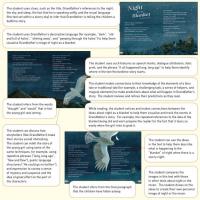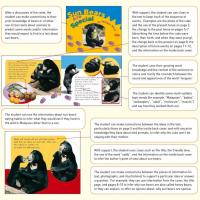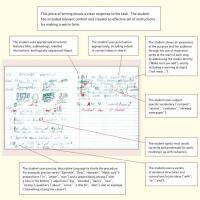After three years at school
The reading standard
The writing standard
The reading standard
After three years at school, students will read, respond to, and think critically about fiction and non-fiction texts at the Gold level of Ready to Read (the core instructional series that supports reading in the New Zealand Curriculum).
Key characteristics of texts at gold level
Texts at Gold level have been designed with characteristics that include:
- some unfamiliar contexts and settings
- shifts in time and/or place
- (in narrative texts) many characters and events and more than one storyline
- a mix of explicit and implicit content within text and illustrations that requires students to make connections between ideas in the text and their prior knowledge in order to make simple inferences
- some pages with no illustrations
- some unfamiliar words and phrases, the meaning of which is supported by the context or illustrations, including descriptive vocabulary, subject-specific vocabulary, and commonly used words that have multiple meanings
- visual language features such as subheadings, text boxes, footnotes, glossaries, indexes, and diagrams and maps that are clearly explained and linked to the body text
- ideas and information organised in paragraphs
- a variety of sentence structures, including complex sentences
- frequent use of dialogue, some of which is not explicitly attributed, and more than one character speaking on a page.
These characteristics support the development of reading behaviours that are described on page 11 and illustrated on the fold-out pages here.
Illustrating the reading standard
'Night is a Blanket' by Barbara Hill; illustrated by Clare Bowes
This text is levelled at Gold 1.
In this story within a story, a grandfather tells a bedtime story to his grandchildren to explain how the moon was formed. This text is one of a collection of linked stories and poems in a miscellany (also called Night is a Blanket). It gives students opportunities to compare ideas about night and the moon across a range of texts and text forms.
This poetic, descriptive text, with its evocative but nonspecific illustrations, requires students to keep track of and visualise a relatively complex series of events and settings.
This example highlights the sorts of reading behaviours teachers could expect to observe in students who are meeting the standard. Sometimes these behaviours will be in response to teacher prompts and questions, and sometimes they will be spontaneous as the students notice and respond to the ideas in the text. These behaviours may be during the first or subsequent readings and discussion.
Sun Bears Are Special by Philippa Werry
This text is levelled at Gold 1.
This report describes a family of Wellington Zoo’s sun bears to illustrate the general characteristics of sun bears and the difficulties involved in breeding them.
This text begins with an apparently straightforward comment about why sun bears are special and then gradually adds more and more information about their special features. The text ends with a strong statement that sun bears are endangered. Students need to identify, and make connections between, information from a number of places to fully identify why sun bears are special.
This example highlights the sorts of reading behaviours teachers could expect to observe in students who are meeting the standard. Sometimes these behaviours will be in response to teacher prompts and questions, and sometimes they will be spontaneous as the students notice and respond to the ideas in the text. These behaviours may be during the first or subsequent readings and discussion.
Return to top
The writing standard
After three years at school, students will create texts in order to meet the writing demands of the New Zealand Curriculum at early level 2. Students will use their writing to think about, record, and communicate experiences, ideas, and information to meet specific learning purposes across the curriculum.
Key characteristics of students' writing at this level
Students will write for a range of different purposes linked to the curriculum, using a process and drawing on the knowledge, skills, and attitudes that will help them achieve their purpose. The knowledge, skills, and attitudes expected at this level, including those needed for spelling and punctuation, are described in the Literacy Learning Progressions.
Students will independently write texts that are clearly directed to a particular audience. They will organise their texts according to a basic structure that meets their purpose for writing (for example, a story with a beginning, a middle, and an end). These texts will include, when appropriate:
- content, mostly relevant, that conveys several experiences, items of information, and/or ideas relating to a curriculum topic and that sometimes includes detail and/or comment
- mainly simple and compound sentences that vary in their beginnings and lengths and in the simple conjunctions used
- attempts at some complex sentences
- some specific vocabulary that is appropriate to the content of the text.
Illustrating the writing standard
Compost worms
The task exemplifies the writing demands of the English curriculum at early level 2.
The context for this piece of writing is a cross-curricular study of recycling. The class has been given a worm farm during a visit from their local council recycling manager, has read 'Worm Wise' (School Journal, Part 1 Number 2, 2002) as a shared reading text, and has made their own worm farms.
The task is to develop instructions for making a worm farm. The teacher has supported the students before the writing by revising the purpose and structure of procedural writing and has reminded the students about making the written instructions clear and precise for the reader. The students are now writing independently.
This is the student’s first draft. Features of the writing that demonstrate the standard are described below.
This example illustrates the sorts of writing that teachers can expect of students who are meeting the standard. To meet the standard, students draw on the knowledge, skills, and attitudes for writing described in the Literacy Learning Progressions for students at this level.
Make a smoothie!
The task exemplifies the writing demands of the English curriculum at early level 2.
The task is to write a recount of an experience. Before the writing, the teacher has supported the students by setting up a language experience activity in which the students made smoothies and discussed what they were doing as they worked. The students are now writing independently.
This is the student’s first draft, with some self-editing. Features of the writing that demonstrate the standard are described below.
This example illustrates the sorts of writing that teachers can expect of students who are meeting the standard. To meet the standard, students draw on the knowledge, skills, and attitudes for writing described in the Literacy Learning Progressions for students at this level.
Published on: 19 Oct 2009
Return to top





